► Launched in the USA and Canada first
► European launch at VW Bus Festival
► Seven seats and a bigger 85kWh battery
The Volkswagen ID.Buzz electric car has made its debut in long-wheelbase, seven-seat form. Previewed first in North America, it was revealed to Europeans on June 24 at the VW Bus Festival in Hanover, Germany – a stone’s throw from the home of VW campers and surrounded by 30,000 Bulli afficionados.
Actor Ewan McGregor, who himself owns several VW buses from a 1958 Transporter to two 1967 Westfalia campers, showed the van off on the main stage of the Bus Festival – remarking: ‘I’ve got five kids – I can fit them all in here!’
The first production vans are set to hit UK roads in mid-2024, when North American models start reaching their owners. The LWB Buzz is the only model sold in the US, but in the UK it’ll be sold alongside the regular-wheelbase, five-seat variant. The new, upsized electric MPV brings added practicality and a larger 85kWh battery pack, which promises to increase maximum range beyond the standard van’s 258-mile figure. It also means that Volkswagen can finally wade into battle with the best electric seven-seaters on sale.
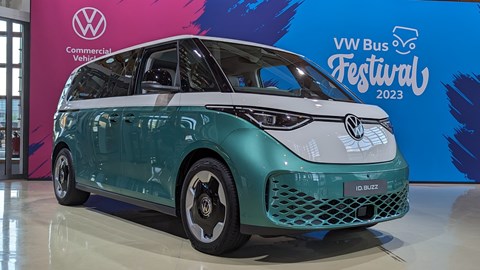
Volkswagen also plans to introduce a performance-focused, all-wheel drive GTX version of the long-wheelbase ID. Buzz in 2024. It’ll feature a dual-motor electric powertrain developing 335bhp, which Volkswagen says will shove the van from 0–62mph in 6.4 seconds. To put that into perspective, that’s the same as a manual-equipped Volkswagen Golf GTI.
What’s changed over the standard ID. Buzz?
Quite a lot. Volkswagen has added an extra 250mm to the electric MPV’s wheelbase, which has liberated the space required for the third row of seats and increased boot capacity to a whopping new maximum of 2,469 litres. The extra wheelbase has also allowed Volkswagen to cram more cells into the van’s battery pack – and there’s a new heat pump to improve efficiency in winter.
There’s a new head-up display, an upgraded infotainment system (with backlit touch-sensitive sliders, at last) and a new remote parking function that can be operated from your smartphone. Volkswagen has also fitted the seven-seat van with a posh electrochromic glass sunroof which can be adjusted from transparent to opaque using either a touch slider on the dashboard or voice commands.

North American buyers will be able to specify the seven-seat ID. Buzz with a new 282bhp electric powertrain. Thanks to its larger body and bigger battery, the long-wheelbase model weighs a bit more than the five-seat variant – but Volkswagen says this new powertrain will increase top speed from 90mph to almost 100mph. Whether it’ll be available in Europe is yet to be confirmed.
Volkswagen has obviously thought carefully about the van’s practicality as, with all the seats folded down, you get a completely flat load space. The stowed rearmost seats match the level of the tumbled second row – and there’s a two-position boot board that can be raised up to the same height as the folded seats. That should make it easier on your back as you won’t need to bend down when loading long, heavy items.
We’ve sat in both rear rows of the Buzz and were impressed by the space on offer. An adult well over six feet tall still has plenty of legroom in the third row of seats, while the middle row is equally spacious and with greater headroom. Access to the third row is easy, too – the sliding doors open way behind the second row of seats, and they tumble forward to create a step – rather than a scramble – through to the rear.
There are four Isofix points back here, though the second row of seats is still made up of a 60:40 bench rather than three individual chairs which is a shame. At least the rear windows slide open, which they don’t in the regular-wheelbase model.
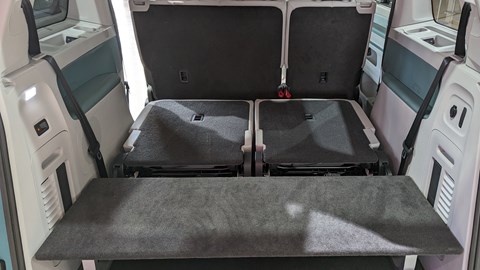
Volkswagen’s cutaway graphics (which you can browse in our gallery) also suggest there’ll be a six-seat version of the ID. Buzz with two captain’s chairs in the second row to replace the standard three-seat bench. Again, whether we’ll get that option in Europe remains to be seen – but we’ll keep you posted.
Volkswagen ID. Buzz GTX expected in 2024
Volkswagen has confirmed it’ll launch a GTX version of the long-wheelbase ID. Buzz in 2024, but the brand hasn’t yet announced whether the more potent powertrain will be available in the standard-length van. It should be possible, though, as its platform is compatible with the same all-wheel drive 335bhp electric powertrain – and it could pinch ID.4 and ID. 5 GTX’s 77kWh battery pack.
We spent some time talking to Volkswagen’s CEO, Thomas Schäfer, and R&D chief, Kai Grünitz. The pair revealed a few details about how the ID. Buzz family will expand in the coming years, confirming that long-wheelbase, GTX and California variants are on the way. Grünitz said: ‘The ID. Buzz GTX will be high-performance and cool. It will have more than 250kW of power.’
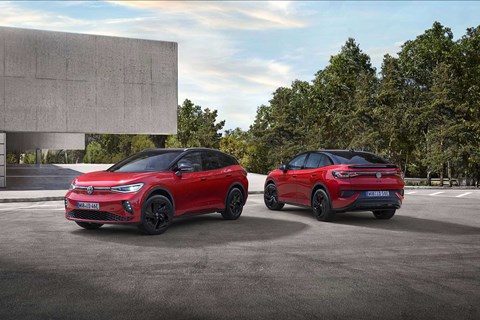 GTX treatment for ID.Buzz confirmed for 2024 but should debut before the end of 2023
GTX treatment for ID.Buzz confirmed for 2024 but should debut before the end of 2023
The new GTX powertrain will give the ID. Buzz a welcome boost. In launch guise, it weighs a hefty 2.5 tonnes and accelerates from 0–62mph in a genteel 10.2 seconds. The upcoming seven seat GTX model will slash that time down to around six seconds – and, if the powertrain makes it into the five-seat Buzz, it might just dip under into the five-second range.
Naturally, the sporty Buzz will get the same range of styling tweaks as the ID. 4 GTX and ID. 5 GTX, because it’s pointless having a load of extra power if your fellow drivers are unaware of it. Grünitz added: ‘The GTX will also get new exterior colours and a dedicated interior.’ Expect larger alloy wheels, a more aggressive body kit and sports seats.
ID. Buzz California campervan yet to be revealed
Volkswagen has been rather secretive about the ID. Buzz California campervan, but chats with executives suggest it’s on the way. It sounds like it’s still in the development stages for the time being, though. Grünitz said: ‘There will be a camper version. We’re working on the first concepts; we’re still investigating what’s possible.’
The official timeline for the all-electric camper has been set for the second-half of this decade. It’ll be loveable, but the challenge will be to make it semi-affordable given the base car starts at £58k. High pricing doesn’t seem to put off conventional VW California buyers, however, and combustion-engined alternatives will continue with a camper based on the Multivan now also confirmed.
Volkswagen ID. Buzz prices and specifications
For now, we only have prices and specs for the five-seat standard wheelbase ID. Buzz. Prices for the seven-seat ID. Buzz won’t be confirmed until Spring 2023.
The most basic Life model starts from £58,915 – and for that, you get 19-inch alloy wheels, heated front seats, a rear-view camera, a 10-colour interior ambient lighting system and a 10-inch touchscreen with wireless Apple CarPlay and Android Auto.
 A face the entire internet has come to love
A face the entire internet has come to love
Above that, there’s the ID. Buzz Style. It’s priced from £63,715 and comes with 20-inch alloy wheels, automatic LED matrix headlights, a 30-colour ambient lighting system and an electrically operated tailgate. The steering wheel, dashboard and centre console are also trimmed in white plastics.
If you’re a tradie, a florist or an artisan baker who doesn’t need the extra seats in the back, you can opt for the Volkswagen ID. Buzz Cargo panel van. Prices start from £43,421 including VAT and the government’s £5,000 plug-in van grant.
What’s under the skin?
The ID. Buzz is based on the same MEB platform as the Volkswagen ID. 3 hatchback – and its design language is a mash-up of that car’s aero-focused swoopiness and the boxy practicality of the classic Volkswagen Type 2. That means you get Volkswagen’s now ubiquitous full-width light bar, two-tone paintwork, short overhangs and a massive VW roundel at the front.
At 4,712mm long it’s significantly shorter than a T6.1 Transporter, but it has roughly the same wheelbase. That means the Buzz sits in the centre of the min-max Venn diagram of interior space and manoeuvrability.
The standard van comes with a 77kWh battery pack and a 201bhp electric motor which, like its ID. 3 sibling, powers the rear axle. As we mentioned above, though, more powerful electric motors and battery packs will be rolled out in the coming months.
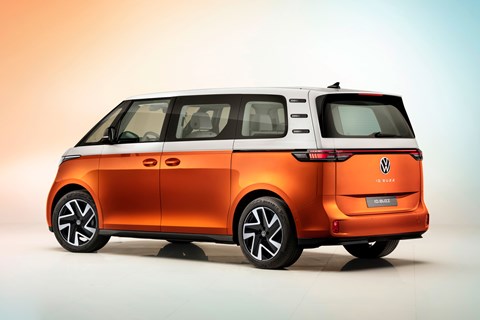 Retro, but not
Retro, but not
The van’s battery pack is integrated into the floor for a low centre of gravity and there’s 170kW charging onboard, which can top battery up to 80 percent capacity in around 30 minutes if you can find a rapid enough DC charge point. Volkswagen also fitted the van with a bi-directional charging system, which means you can use the energy stored in the ID. Buzz’s battery to power your home.
Experiments with a fully autonomous variant are also well underway – and Volkswagen says it aims to offer this before 2025.
What about the interior?
The basic van features a lot of black plastic, but higher-spec models have brightly coloured upholstery and a splash of faux wood across the dashboard. Every version shares the same huge central touchscreen and column-mounted instrument display, though – and there are loads of clever storage systems, including a large shelf above the glovebox lined with grippy rubber and the ‘Buzz Box’ storage bin between the front seats.
The materials are a little different, too. You won’t find any leather here – the upholstery is made from recycled plastics. There are loads of little Easter eggs peppered around the cabin, too, from little smiley faces on the screw covers to embossed vans in the armrests.
 Mmm, screens
Mmm, screens
Despite this, we’re a little disappointed by the ID. Buzz’s cabin because it isn’t as useful for families as we’d like for a van. The rear bench a conventional 60/40 split affair, instead of three individual seats. That means it won’t be as handy as a Peugeot 5008 for fitting three child seats side-by-side. There’s also no Isofix point for the front passenger seat.
Tell me about the Cargo variant
The van version looks similarly funky – and it can be specified in a few different ways to suit your requirements. So, there’s a choice of a full-height tailgate or barn doors at the rear, while the front seat can be either a two-seater bench or an individual pew.
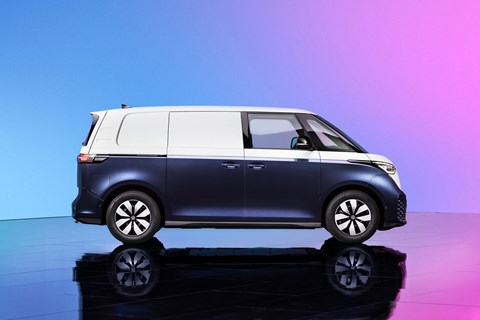 Sharp-dressed van
Sharp-dressed van
There’s space for two Euro pallets and a rather measly payload of just 650kg in the rear, behind a fixed bulkhead with an optional load-through flap.